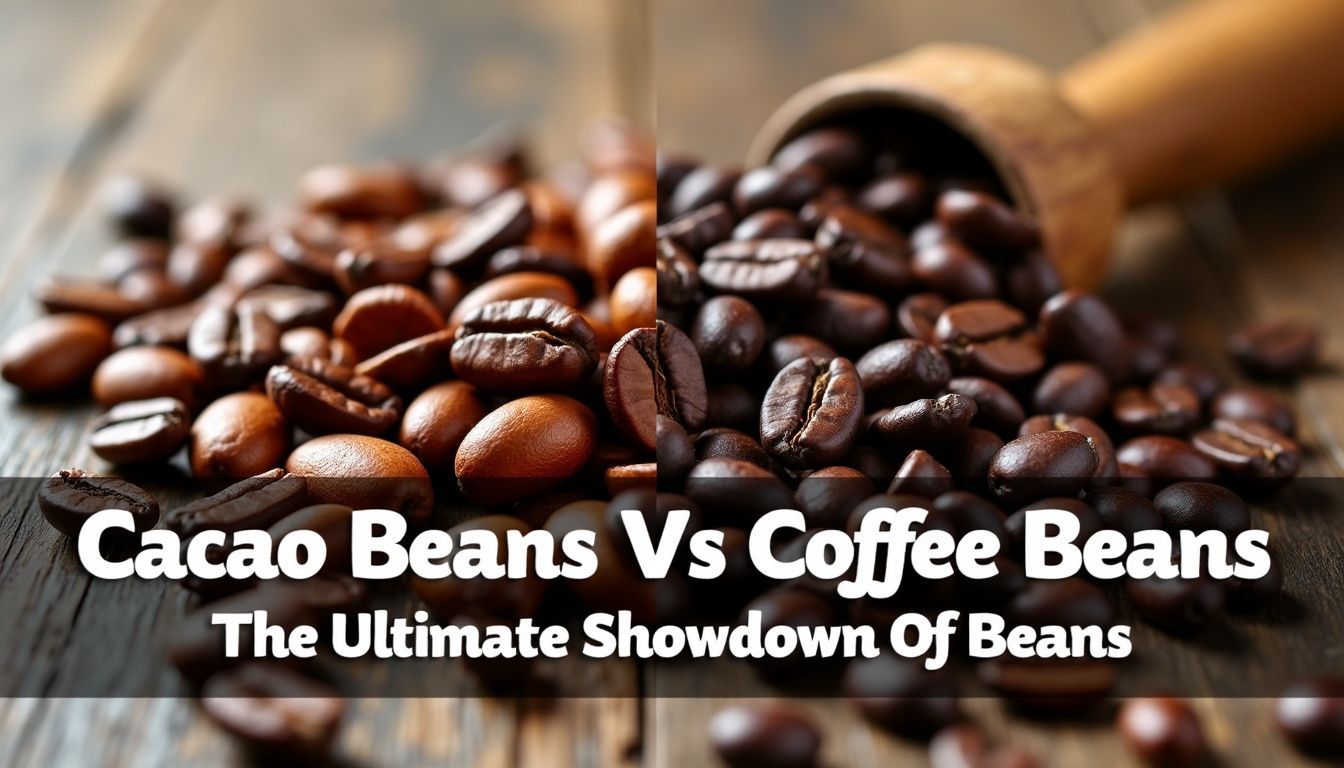Cacao Beans Vs Coffee Beans: The Ultimate Showdown Of Beans
You love your morning brew, but you’re curious about cacao. What’s the difference? What distinguishes cacao beans from coffee beans?
Coffee claims global attention with 400 billion cups consumed annually, but cacao also holds its ground. This blog introduces the clash between these beloved beans by exploring taste, health benefits, and historical roots.
Cacao offers chocolatey richness while coffee provides vital caffeine. Their origins shape unique cultures and traditions, inviting discovery and experimentation in daily rituals. Embark on this journey and decide your preferred bean.
What Are the Differences Between Cacao Beans and Coffee Beans?
Cacao and coffee beans have distinct characteristics in terms of origin, use, and nutritional content. Here’s a quick comparison:
| Cacao Beans | Coffee Beans | |
|---|---|---|
| Origin | Amazon rainforests, South America | Ethiopia’s Kaffa region |
| Primary Use | Chocolate products | Coffee beverages |
| Caffeine Content | About half of coffee beans | 95 grams per typical cup |
| Mineral Content | Higher in iron, calcium, potassium, magnesium, copper, zinc, phosphorus | Lower mineral content |
| Fat Content | 50% | 14% |
| Carbohydrate Content | 20% | 50% |
These differences affect taste, health benefits, and uses in food and drink.
The Origins and History of Cacao and Coffee Beans
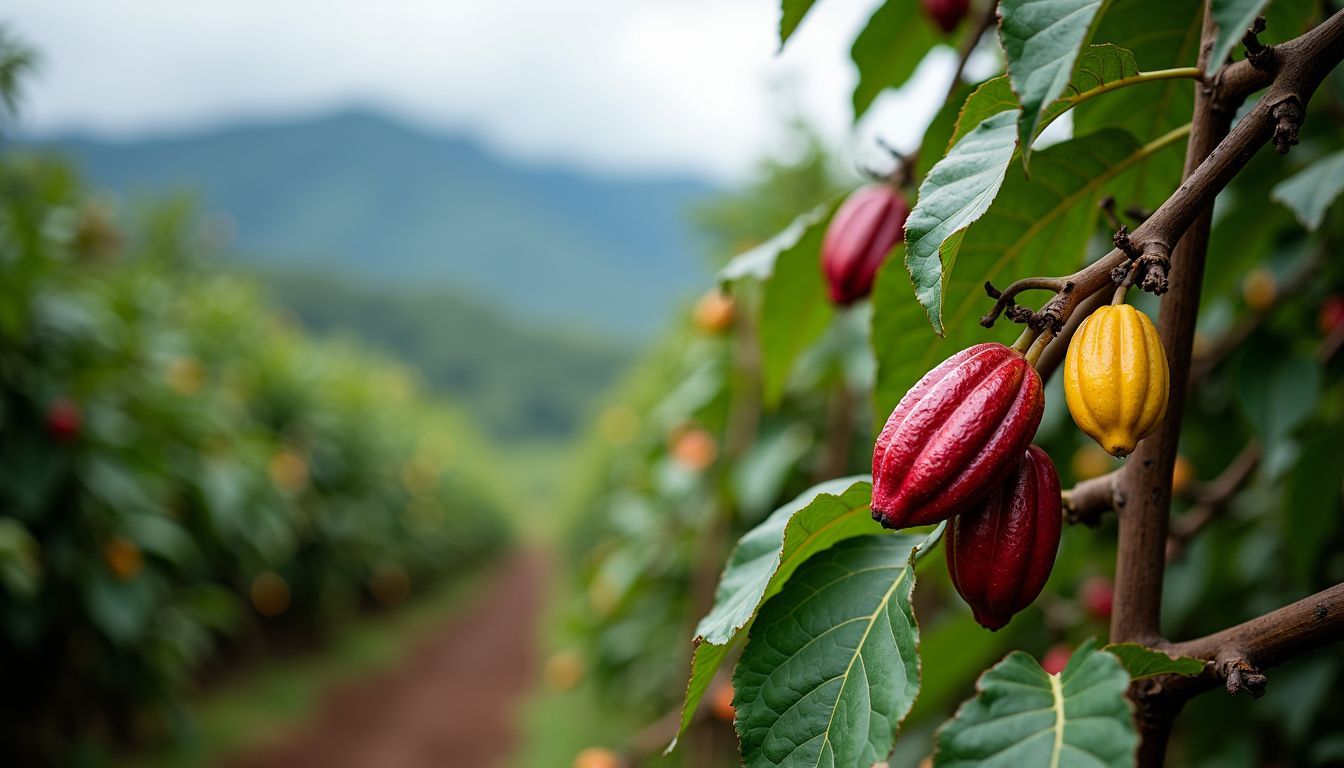
Cacao’s story starts with the Maya around 1000 BC. They grew cocoa trees and made drinks from the beans. A pot found in Guatemala shows they used cacao early on. The Maya loved their cocoa and saw it as a gift from the gods.
Coffee’s past is less clear, but a fun tale exists. It says Kaldi, a goat herder in Ethiopia, saw his goats get lively after eating red berries. This happened about 800 AD. Coffee then spread to the Arab world.
By the 1600s, it was big in Europe. Both drinks took time to catch on, but now they’re loved worldwide.
How Cacao and Coffee Beans Are Grown and Processed

Cacao and coffee beans grow in tropical climates. Their cultivation and processing differ greatly.
- Cacao trees need shade and high humidity. Coffee plants do well in full sun at higher altitudes.
- Cacao pods ripen at different times. Workers pick them carefully by hand.
- Coffee cherries turn bright red when ripe. Farmers often use machines to collect them.
- People crack open cacao pods to extract the beans. The beans then ferment for about six days.
- Coffee cherries go through washed, honey, or natural processing. Washed process removes the fruit flesh before drying.
- After fermentation, cacao beans dry in the sun. This reduces moisture from 60% to 7%.
- Cacao beans mature for 30 days to a year. This step enhances flavour.
- Coffee beans don’t need maturing. They’re ready for roasting after drying.
- Both cacao and coffee beans go through roasting. This step brings out their unique flavours.
- The final products are different. Cacao becomes chocolate. Coffee beans are ground for brewing.
Caffeine Content: Cacao Beans vs Coffee Beans
 Caffeine levels differ greatly between cacao and coffee beans. Here’s a breakdown of their caffeine content:
Caffeine levels differ greatly between cacao and coffee beans. Here’s a breakdown of their caffeine content:
| Cacao Beans | Coffee Beans | |
|---|---|---|
| Caffeine per serving | 35mg | 95mg |
| Absorption rate | Slow (due to cacao butter) | Fast |
| Side effects | Minimal | Can be significant |
| Other stimulants | Theobromine (reduces cortisol) | None |
| Energy boost | Mild, sustained | Strong, immediate |
Coffee beans contain more caffeine. You’ll receive nearly triple the caffeine from coffee compared to cacao. However, cacao’s slower absorption results in a more gradual energy increase.
Additionally, cacao’s theobromine helps reduce stress. Coffee might cause restlessness, while cacao tends to have a calming effect. You can select your preferred bean based on the type of energy boost you desire.
Nutritional Differences and Health Benefits of Cacao and Coffee Beans

Cacao beans offer substantial nutritional benefits. They contain high levels of antioxidants, particularly flavanols, which support cognitive function and memory. Cacao is also a good source of iron, calcium, and magnesium.
It’s beneficial for heart health as well. Regular consumption of cacao may help reduce blood pressure and cholesterol levels.
Coffee beans provide different advantages. They have a lower fat content – approximately 14% compared to cacao’s 50%. However, they can increase blood pressure. Both types of beans have their own unique benefits.
Cacao supports heart health, while coffee may help reduce the risk of Parkinson’s disease. You can select based on your specific health objectives and flavour preferences.
Flavour Profiles: How Do Cacao Beans and Coffee Beans Taste?
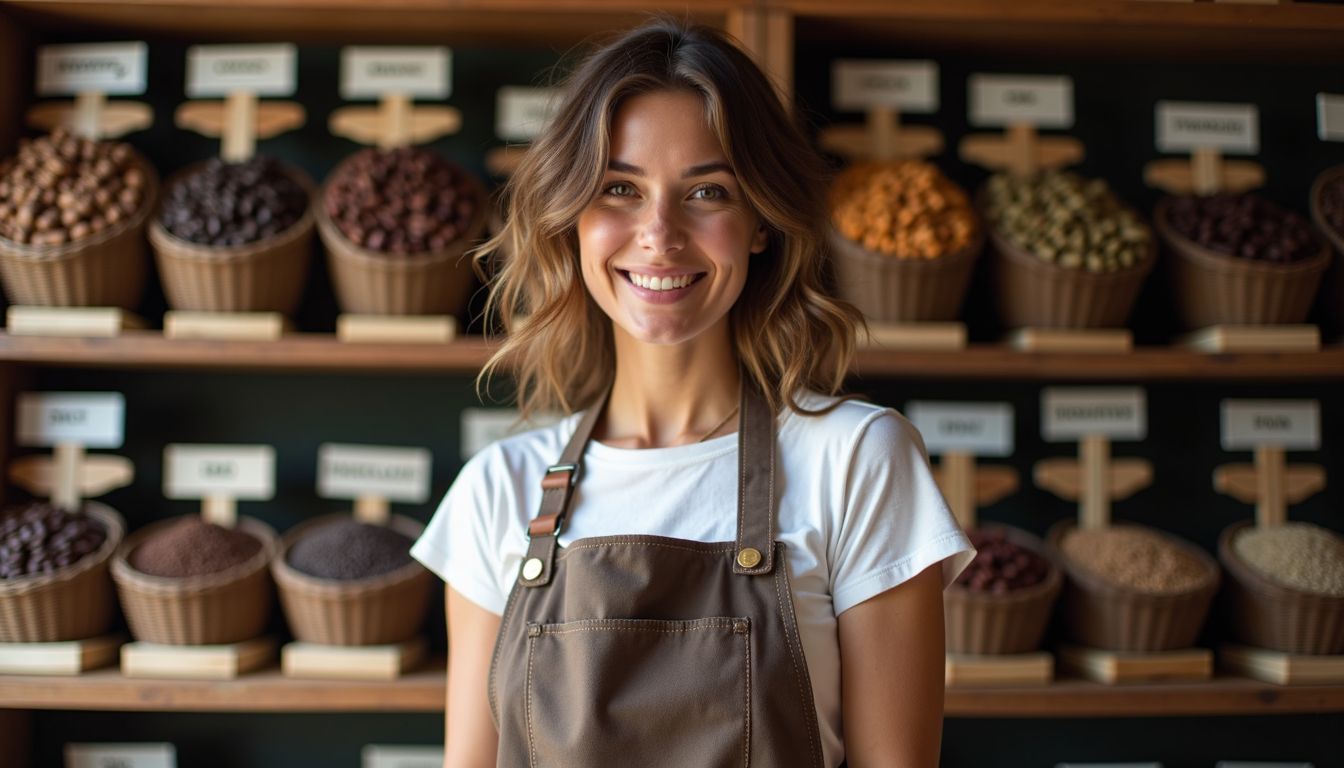
Coffee beans offer earthy, woody, and citrusy notes. You’ll taste hints of chocolate, nuts, or fruit. Cacao beans bring fruity, floral, and nutty flavours with a touch of bitterness.
The roasting process shapes these tastes. Coffee roasts at over 200°C, while cacao needs lower temps of 120-135°C. This affects the final flavour.
Fermentation plays a big role in cacao’s taste. It creates over 88 different compounds. These include alcohols, acids, and esters. They give cacao its complex profile. For fruity and floral notes, roast cacao at 110-116°C.
For caramel flavours, aim for 130-135°C. Unlike coffee, cacao doesn’t change colour much during roasting.
Common Uses and Products Made from Cacao and Coffee Beans

Cacao and coffee beans offer a wide range of uses beyond their primary products. Here’s a list of common applications for these versatile beans:
- Chocolate bars: Cacao beans form the base of milk, dark, and white chocolate.
- Hot cocoa: Ground cacao makes a rich, warming drink.
- Coffee drinks: Espresso, cappuccino, and latte all start with coffee beans.
- Iced coffee: Chilled brewed coffee served over ice.
- Cocoa butter: Used in skincare products and some chocolates.
- Coffee-flavoured desserts: Tiramisu and coffee ice cream use coffee beans.
- Cocoa powder: Added to baked goods for chocolate flavour.
- Coffee liqueur: Alcoholic drinks like Kahlúa use coffee beans.
- Cocoa shell mulch: Garden mulch made from cacao bean shells.
- Coffee grounds: Used as plant fertiliser or body scrub.
- Cacao nibs: Crushed cacao beans added to trail mix or smoothies.
- Coffee extract: Flavouring for cakes and other sweets.
- Cocoa juice: Made from the pulp of cacao pods.
- Coffee-scented candles: Use coffee bean essence for aroma.
- Cacao brandy: Alcoholic drink made from fermented cacao pulp.
Cultural Significance of Cacao and Coffee Beans
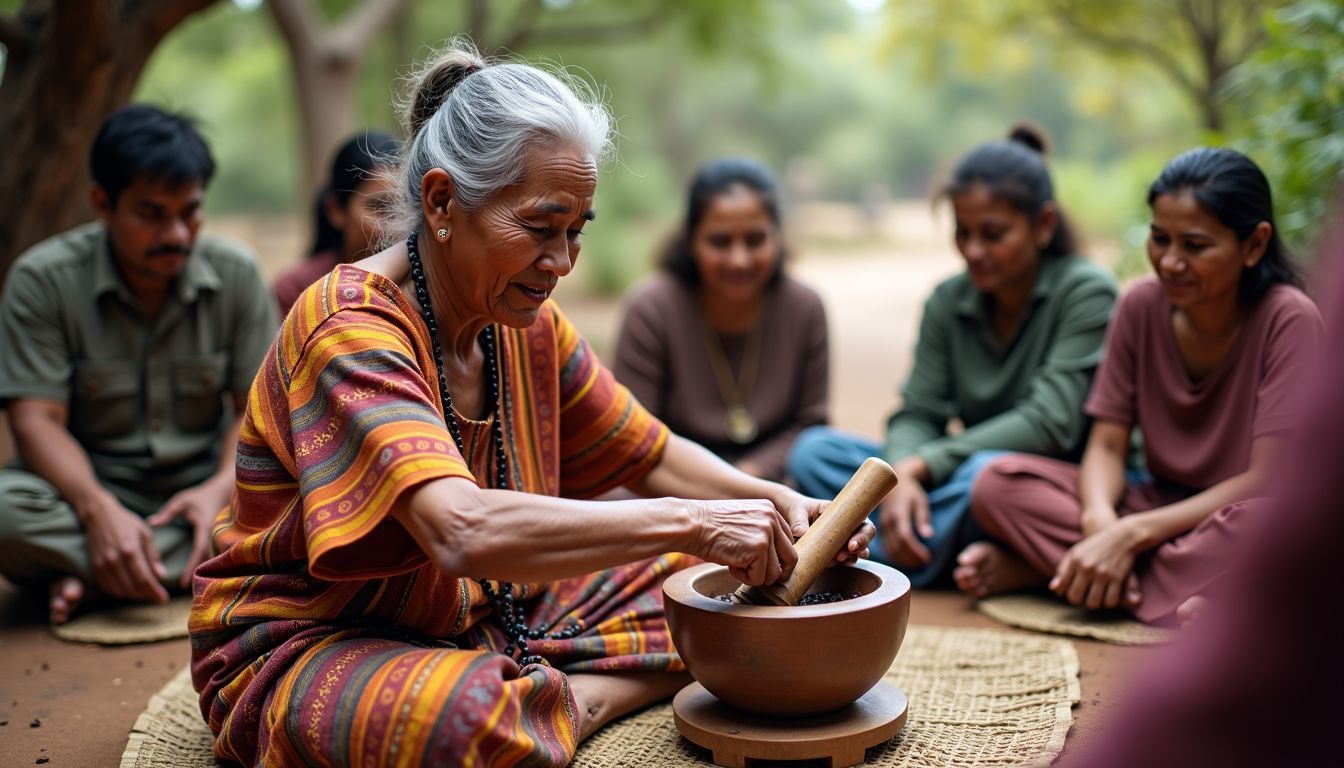
Coffee and cocoa hold deep cultural roots worldwide. In Ethiopia, coffee plays a key role in social life. The Ethiopian coffee ceremony brings people together, showing respect and community spirit.
It’s a ritual that can last hours, with beans roasted, ground, and brewed on the spot. Guests chat and bond over the rich aroma and taste.
Cocoa has its own special place in history. The Maya called it “Food of the Gods” and used it in many ways. They drank it in rituals, used it as money, and enjoyed it at big events.
In Europe, both drinks gained fame in the 1600s. Coffee shops became hubs for smart talk and new ideas. Cocoa was seen as a healthy drink, while coffee became part of daily life. Today, these beans still shape cultures and bring people together.
Environmental Impact of Cacao and Coffee Bean Farming
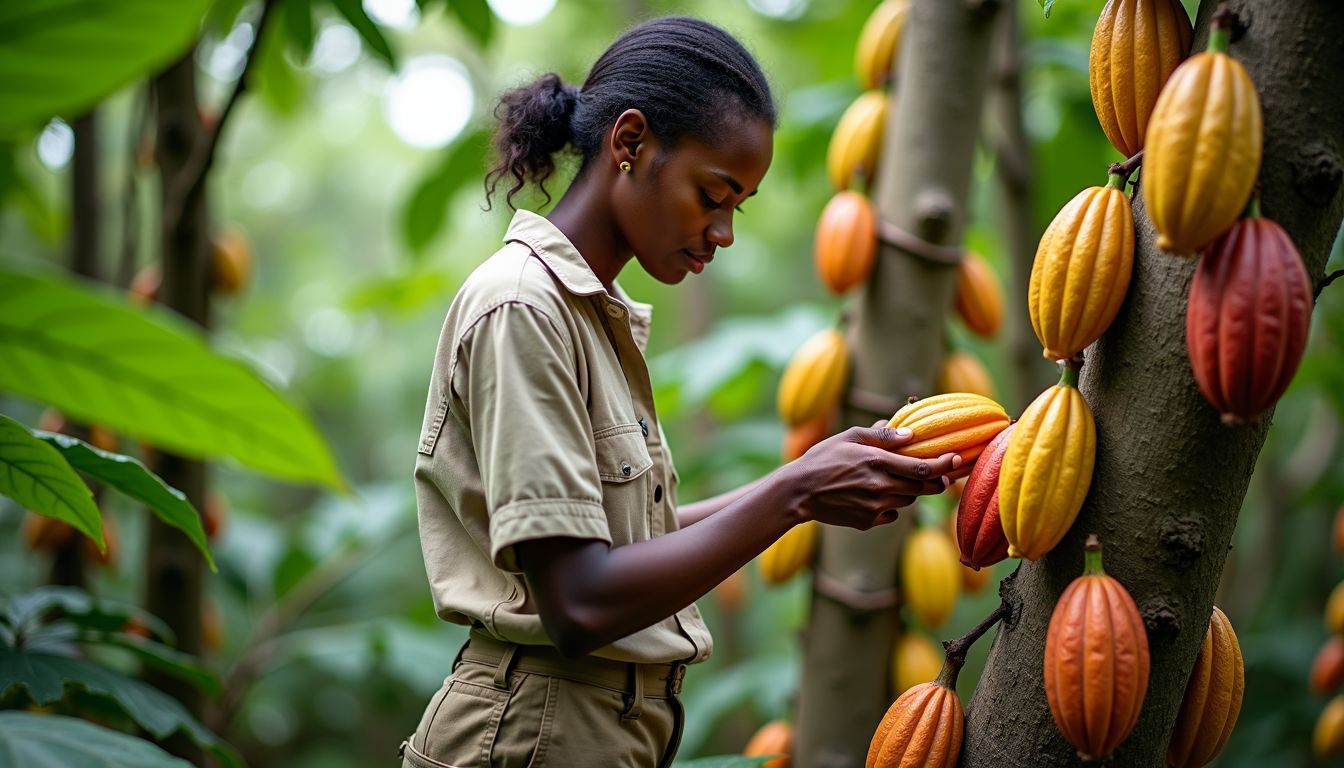
Cacao and coffee farming negatively impact the environment. Forests are cleared to cultivate these crops. In Cote D’Ivoire, 70% of illegal deforestation is associated with cacao farms.
Farmers utilise harmful pesticides that contaminate water sources and harm flora and fauna. Only 16% of chocolate is sourced from sustainable cacao farms. These farms support biodiversity and yield higher quantities of beans.
Land use changes are the primary source of environmental damage from coffee and cacao farming. Forests are cleared to establish new plantations. This damages wildlife habitats and exacerbates climate change.
Improved agricultural practices can mitigate these issues. Employing less harmful pesticides and avoiding deforestation can make a substantial difference. You can contribute by purchasing coffee and chocolate from sustainable farms.
Conclusion
Coffee and cacao beans provide distinctive flavours and advantages. Both grow in tropical areas but flourish in different environments. Coffee contains more caffeine, whilst cacao has higher levels of antioxidants.
Your preference depends on taste and health objectives. Sample these beans to discover your ideal brew or treat.
Frequently Asked Questions
What Are Cacao Beans?
Cacao beans are seeds from the Theobroma cacao tree, primarily used in the production of chocolate. They are rich in antioxidants, particularly flavanols, which support cognitive function and memory.
Are Coffee Beans Actually Beans?
No, coffee beans are not true beans; they are the seeds of the Coffea plant. Despite their name, they serve as the primary ingredient in coffee beverages.
How Does Fermentation Affect Flavor in Cacao and Coffee Beans?
Fermentation is a crucial process used to develop the flavor in both cacao and coffee beans. It reduces bitterness and enhances the complexity of the flavor profiles, contributing to the rich taste we associate with chocolate and coffee.
How Do Cacao Beans and Coffee Beans Differ in Caffeine Content?
Cacao beans contain less caffeine than coffee beans. The caffeine in cacao offers a mild, sustained energy boost, partly due to the presence of theobromine, which provides a calming effect, while coffee provides a stronger, immediate energy boost.
What Health Benefits Do Cacao Beans Offer Compared to Coffee Beans?
Cacao beans are rich in antioxidants, which support heart health and cognitive function. Coffee beans also offer health benefits, such as potentially reducing the risk of Parkinson’s and liver diseases, but can increase blood pressure if consumed in excess.
What Is the Environmental Impact of Cacao and Coffee Farming?
Both cacao and coffee farming have significant environmental impacts, including deforestation and biodiversity loss. Sustainable farming practices are essential in mitigating these effects and ensuring ethical sourcing of these products.
Why Is Theobromine in Cacao Beans Significant?
Theobromine, present in cacao beans, is a stimulant similar to caffeine but with a milder effect. It helps reduce cortisol levels, offering a calming effect, which can be beneficial for stress management.
